DIY Solar-Powered PC
This is part one of the three part article. Part 3 is here.
Frank VölkelSeptember 6, 2007 07:30
[The original article with ads and all was found here.]
Solar-PC: Turning Sunlight Into Computing Power
Even serious PC power junkies eventually understand that a high-performance PC costs some serious money. Over time, what really costs on such rigs is not the individual components but rather, the power such systems consume from the wall socket. A truly awesome system can suck up in excess of $500 a year in electricity. Ever-increasing energy costs, changes in government outlooks, and a new passion for conservation keep upping the ante and the interest in photovoltaic technologies.
All this helps to explain why we've been working our way through an exciting project in our Munich laboratories for the past couple of years: acquisition of solar cells to drive a state-of-the-art PC completely off the grid for continuous 24/7 operation. During this process, we spent weeks in designing and configuring the system you'll learn more about here. But to kick off our discussion of this do-it-yourself project, let's dig into the basics of converting solar power into usable electricity.
Foundations Of Photovoltaic Technology
When it comes to going solar, energy conservation trumps all other concerns, though we did our best to design and deliver a pretty powerful desktop PC. Otherwise, we could simply have driven any of a number of notebook PCs using solar energy without expending too much time or effort on this task. But one of our chief goals in conceiving this article was to base this project on a conventional, state-of-the-art desktop PC intended for everyday use, including a large-format, high-resolution display, reasonable computing performance, and a full-size keyboard.
THG used polycrystalline silicon solar cells for this project
What we must state baldly and clearly from the get-go is pretty dramatic: Our completed solar PC, which automatically compensates for available sunlight, consumes power at peak levels of around 290 Watts. Thus, it should come as no particular surprise that the complete hardware requirements for such a system, including solar components, is not cheap. Nevertheless, we see this as a step into the near future, where our experiment in solar energy delivers an achievable system that can also help propel computer users into an entirely new way of computing - namely, a high-performance, energy-conserving PC that runs entirely on solar power. For under $3,000, you can either spend your money on an ordinary high-end PC, or you can invest in the ultimate form of energy efficiency - an energy conserving, high-powered PC system that works entirely off solar energy.
Generate Your Own Juice
Automatic tracking gear is the key to successful solar power generation
Our project qualifies as a so-called insular solar system, which has no connection to the power grid. This confers the advantage of eliminating any need for a transformer to convert our solar panel output to standard 110-120V, 60 Hz AC power, and lets us connection our PC system directly to the solar panels using only a voltage regulator. At night or on especially cloudy days we can turn to a backup battery for power, which we keep charged up during sunny daylight hours. Even in Germany, where we conducted this experiment, the sun's rays are sufficient to meet our energy needs more than 80 times over. Our solar array makes PC users indifferent to energy prices, and offers lots of potential for optimization and further experimentation. Once paid for, the equipment involves very little ongoing costs, including costs for energy.
In fact, there are some situations where energy generation using solar cells is the only option, including locations not connected to the power grid. Thus, for example, various mountain cabins in Bavaria do not have power hookups, and face costs upward of $35 per foot to run power cables to make a connection. There are also expensive grounding and connection costs involved as well, which makes some of these hookups far from simple. Even if somebody wanted to connect to the grid, it's possible that environmental regulations might not allow cables to be run, and costs quickly surpass $30,000 or more to make the connection.
Germany also has an extensive system of public gardens, called Schrebergarten, where individuals can rent small strips of land on which to grow vegetables, crops, and other plants. Very often, these small plots include small garden huts or outbuildings, that have no access to the power grid, either. The only source for electricity in this situation is solar power. Some might seek to argue for diesel or gasoline generators instead, because they're available for a few hundred dollars on the open market. While it's true that a generator might be a simpler and cheaper solution for powering a PC, not everybody is ready to put up with the noise and pollution that such systems also produce, in addition to power.
Special solar batteries for use with solar cells: 130 Ah capacity
Precision measurements: Power readings from the Voltech PM 3000A detail power yields from solar energy
The applications for solar power are broad. For example, an author or a scientist can work in peace and quiet, far from civilization, without requiring any contact with the outside world. This kind of system also makes it possible to process and enhance photos and videos, and even permits camera batteries to be recharged using solar energy. Don't forget, either, that for many users, a completely solar-powered PC can become something of a sociopolitical statement as well.
Tom's Hardware Solar Project: Thick copper cabling required
The battery clamps for the storage cells are like those from a car
1,800 Hours Of Annual Sunlight
Southern Germany is better than the north end: Sunlight intensity measurements mapped
In the summertime on a cloudless day in Munich the sun delivers approximately 1100 Watts per square meter (about 102 watts per square foot). In bad weather, this drops to as low as around 100 watts (about 10 watts per square foot). The theoretical maximum bandwidth of visible sunlight the maximum practical efficiency is more like 29 percent. The energy available from sunlight also depends on the angle at which the sun's rays strike the earth's surface as well. Axial tilt of the earth also means that this angle changes with the seasons, so that significantly less solar energy is available in winter months (especially in Germany) than in the summer, because days are shorter and the sun climbs less high into the sky.
Average solar energy per square meter in kilowatt hours per day
In the Munich area, solar cells deliver maximum energy when inclined at 28 degrees and oriented toward the south. Our own measurements show that even small errors in orientation and inclination can diminish yearly energy totals significantly. Without adjusting the solar cells daily for changes in orientation to match the sun's track across the sky, overall energy levels likewise also dip severely. Exact instructions to optimize solar cell position may be found in the second and third parts of this series of articles.
But if you plan to deploy solar cells on a rooftop, a fixed orientation is usually the only kind that's feasible. With a southwest or southeast facing roof and an inclination of 45 degrees, for example, you need to install a larger solar array, to match the same energy output at a 28 degree inclination facing south. If you're willing to take that kind of approach, however, nearly any rooftop area may be used for solar panels, as the following illustrations indicate.
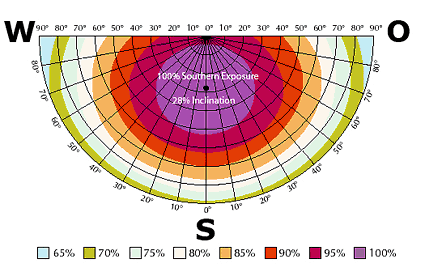
Optimal energy delivery occurs at an inclination of 28 degrees toward the south
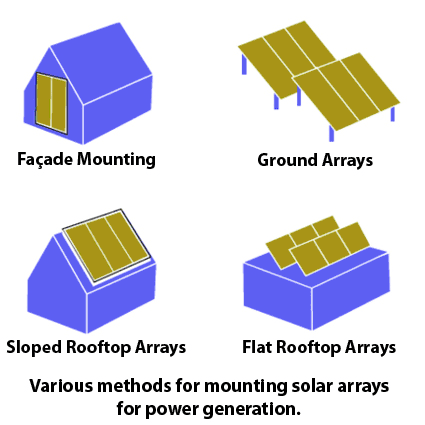
Possible mounting strategies for rooftop solar panels
When it comes to use of solar panels, there are profound differences between northern and southern Germany, as there will be in other parts of the world. The closer one gets to the equator, the more usable solar energy becomes available, which explains why more southerly regions generally do better when it comes to making use of solar energy. Thus, for example, Munich receives nearly 1800 hours of sunlight per year. Despite changeable weather conditions, the month of July routine attains 260 hours of sunlight, an amount that produces an enormous energy output for solar panels at optimal inclination and orientation. The following tips should help those interested in using solar cells to drive PCs (and eventually others) achieve the best results:
- an area as free of shade as possible (rooftop or unshaded ground area)
- Roof orientation from east to west is workable, but best energy outputs come from southerly rooftops inclined between 20 and 40 degrees
- sufficient solar panel surface area for desktop PC use
- good ventilation or air circulation around solar panels for cooling (helps energy efficiency)
- optimal energy delivery occurs when solar panels can be oriented to match the sun's exact celestial position
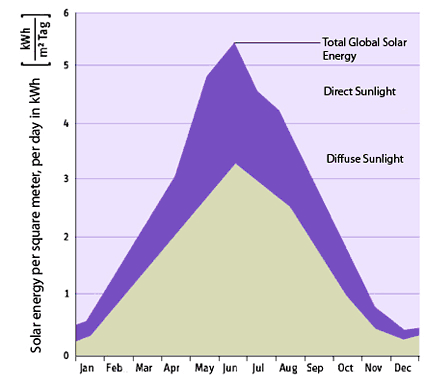
The highest global levels of sunlight occur during the summer months
The southern advantage: Sunlight hours in June 2007
Solar Cell Types: Up To 25% Efficient
Industrial-grade solar modules from Sharp come in mono- and polycrystalline forms
Each solar array panel includes a total of 36, 72, or even 96 individual standard solar cells. In the recent past, cell sizes have attained nearly 5" square (125mm) dimensions. The most commonly used type of solar cells are made of thick-film silicon, whose efficiency ratings go up to relatively high values of 20 percent for polycrystalline cells, and up to 25 percent for monocrystalline cells. In the still relatively brief history of solar cell technology, many types of solar cells have been developed, all of which differ in terms of how panels may be contructed and how well they convert solar energy into electricity. For industrial and home use for participation in the power grid, solar cells made of monocrystalline or polycrystalline silicon are most commonly used. The lower efficiency ratings for polycrystalline silicon are more or less offset by their lower costs. The preceding photograph shows the relative surface areas required to generate 1000 Watts of electricity for the various types available.
Solar arrays made from amorphous silicon can be mounted as a leisure time activity. The thin-film technologies known as CIS (Copper Indium diselenide) and Cadmium-Tulluride (CdTe) only command about a 2 percent marketshare at present. But solar panels made of these materials enjoy some considerable advantages when compared to those made of crystalline silicon. First and foremost, they are about 100 times thinner than crystalline materials, which makes their packaging much thinner as well. It's also the case that thin-film solar panels can utilize diffused or weak sunlight--as when the sky is obscured by clouds--much more efficiently than crystalline modules. This makes the thin-film modules much more tolerant of partial shade as well. Another advantage comes from their tolerance for higher operating temperatures, typical in areas that receive ample sunlight. But thin-film panels have their disadvantages as well: to achieve the same levels of energy output as thick-film modules, they require larger surface areas for energy collection and generation.
Various types of solar cells, including monocrystalline and polycrystalline thick-film Silicon all the way through thin-film types
Energy efficiency for thick-film solar cells
- monocrystalline silicon 25%
- polycrystalline silicon 20%
Energy efficiency for thin-film solar cells
- amorphous silicon 10%
- CdTe 16%
- CIS/CIGS 20%
- nanocrystalline Si 10%
- micro-/polycrystalline Si 10%
- polymerous Si 5%
In actual use, cells are connected in series, to accumulate sufficient voltage from the 0.6V that a standard cell delivers to deliver usable voltage levels. Industrial grade solar modules are built from individual cells, interconnected with wiring and sandwiched between glass plates and polymer films for protection. Thin-film cells are also available in large interconnected arrays, sometimes even in auto-positioning carriers.
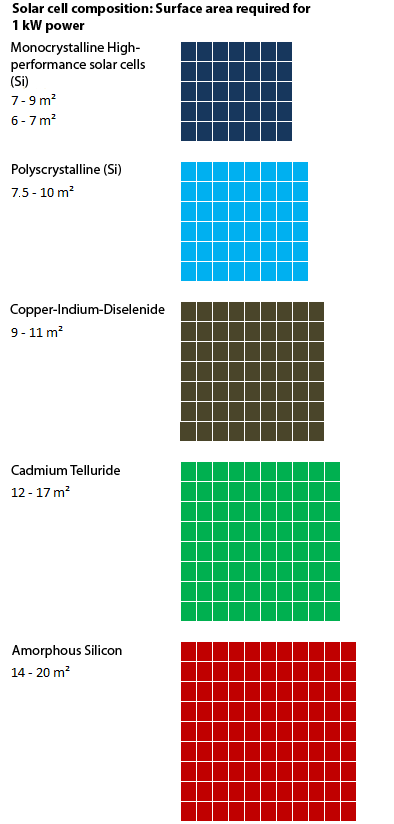
The size of the surface area required to deliver 1,000 Watts depends on the material used for solar cell construction
For thick-film cells, mechanical carriers and photovoltaically active materials are the same. These cells are manufactured in much the same way as CPUs and graphics chips are made, using silicon wafers.
Industrial-Grade Solar Cell Vendors
When it comes to solar power, Germany is way ahead of the USA, Japan, and Spain
It's primarily a result of government policy that Germany enjoys the highest global level of innovation and investment when it comes to solar power. Even in rankings for worldwide solar power generation, Germany (Study for 2010) holds first place with 36 percent of all installations, with the USA at 15 percent, and Spain at 8 percent. All told, more than 1000 megawatts (1 gigawatt) of power is being generated exclusively from the sun. We also provide another graphic that shows just how small the portion of solar-derived energy really is, as compared to total worldwide energy generation. There are only a limited number of solar cell manufacturers around the world, and most of them simply repackage standard solar cells into panels or arrays. The following list shows the top 7 solar cell manufacturers:
- Sharp 28%
- Q-Cells 11%
- Kyocera 9%
- Sanyo 8%
- Mitsubishi 7%
- RWE Schott Solar 6%
- BP Solar 5%
Germany also leads the pack with the largest photovoltaic installation in the world, located in the Erlasse winery in Franken, Bavaria. There, a total of 1,408 solar arrays generate 12 megawatts of power, to provide a town of 8,500 inhabitants with electricity. Here's an overview of the leading solar power installations in Germany:
- Erlasse winery, Franken, Bavaria: 16,896 solar panels (1,480 Solon Mover arrays), with 12,000 kW
- Solarpark Bavaria, Mühlhausen, Bavaria, 57,600 individual solar panels, 6300 kW
- Solarpark Leipziger Wand, Sachsen, 33,500 solar panels, 5000 kW
- Solar roof München-Riem, Bavaria, 1000 kW
- Berlin's main train station, the Lehrter Bahnhof, has 780 solar panels, 1,700 m2, 180 kW
- German Chancellor's office, Berlin, 756 solar panels, 1,270 m2, 150 kW
Large installation: Roof mounting of polycrystalline silicon panels at a factory
Future view: Solar panels all over the rooftops in family housing
Sensible: Complete integration of solar panels into roof construction
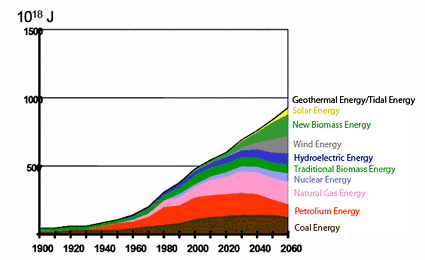
The worldwide portion for solar energy remains miniscule
Summary: Generate Up To 15 Watts Per Square Foot
On a cloudy day, energy delivery from polycrystalline solar cells isn't very good
As long as a year ago, Tom's Hardware began work on an experimental solar installation that was decommissioned in late September, 2006. That increased the pressure on our second attempt to power a normal desktop PC entirely from solar sources. In particular, we felt it was important to build our test PC using the most energy efficient components available. Now, we've completed that assignment and offer this series of articles as a guide to what a project that should be equally fascinating to our readers, whom we encourage to follow in these footsteps. In fact, our high-performance desktop PC remains up and running, powered 24/7 by two compact solar panels.
The cable used to run power from the solar panels to the PC is between 1 and 2 gauge (16 mm²).
We used solar panels built from polycrystalline silicon that delivered a maximum of 290 Watts of power during testing for our project. Additional details and step-by-step instructions will be provided in the next installments in this series of articles. The location and orientation of the Tom's Hardware Munich test labs, coupled with our ability to orient these solar cells optimally on our roof, enabled us to generate high energy levels from this rig. We included storage batteries in our setup so that we could remain independent of the power grid, even on cloudy days, or while it was raining.
As we put this future-friendly set-up together, we found ourselves forced to improvise, and to make use of custom-built circuit boards. In the next installment we'll present the PC components we chose for our solar-powered desktop PC, where every watt of power consumed (or conserved) matters a lot. Along the path to our final configuration, we also tested a lot of hardware components, and measured their power consumption.

